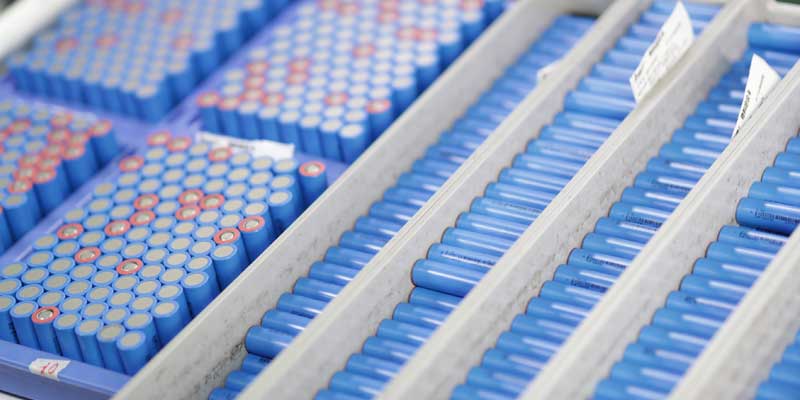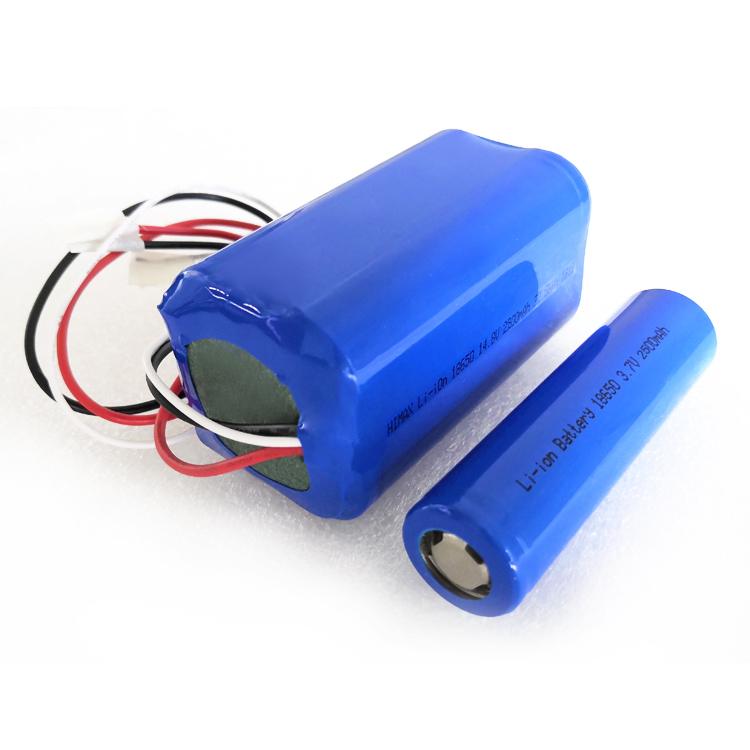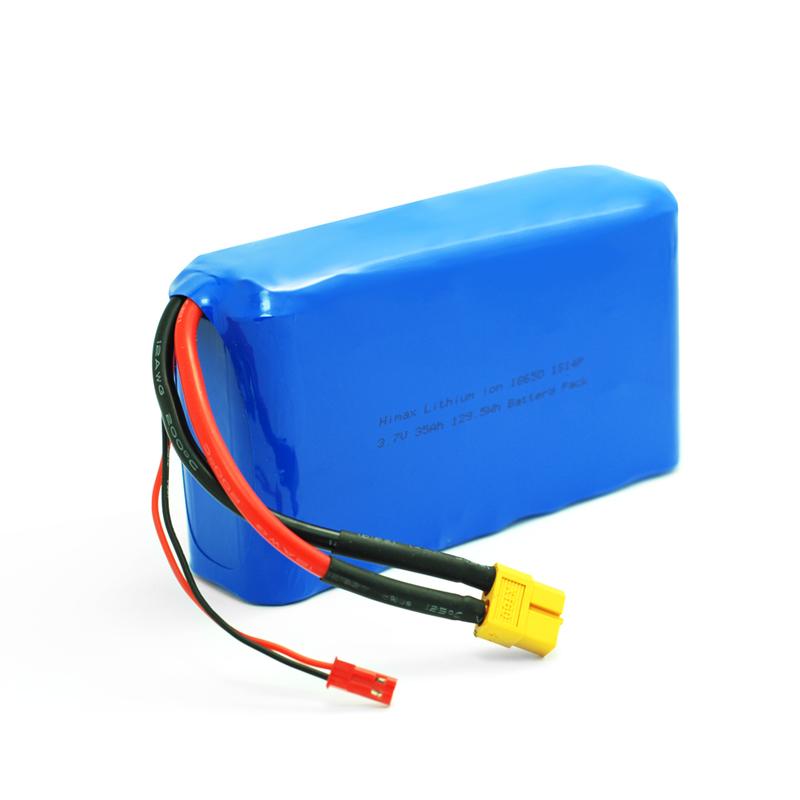A comprehensive guide to battery cathode and anode
When designing custom lithium battery pack, it is very important to correctly calculate the reasonable ratio of positive and negative electrode capacities. For traditional graphite negative electrode lithium-ion batteries, the main shortcomings of battery charge and discharge cycle failure mainly occur in lithium deposition and dead zone problems on the negative electrode side, so the solution of excess negative electrode is usually used. In this case, the battery capacity is limited by the capacity of the positive electrode, and the ratio of negative electrode capacity/positive electrode capacity is greater than 1.0 (i.e. N/P ratio >1.0).
If there are too many positive electrodes, excess lithium ions from the positive electrode cannot enter the negative electrode during charging, and lithium will be deposited on the surface of the negative electrode, leading to the formation of dendrites, thus affecting the cycle performance of the battery. Therefore, generally speaking, the graphite negative electrode in custom lithium battery pack will have slightly more than the positive electrode, but not too much. Too much negative electrode will consume the lithium in the positive electrode. In addition, this will also cause waste of negative electrodes, reduce battery energy density, and increase battery costs.
For lithium titanate anode batteries, due to the relatively stable LTO anode structure, high voltage platform, excellent cycle performance, and no lithium deposition, battery cycle failure mainly occurs on the cathode side. The preferred solution for battery system design is to use excess positive and negative capacity limits (N/P ratio <1.0), which can alleviate electrolyte decomposition problems due to high positive electrode potential when the battery is near or fully charged.
N/P ratio refers to the ratio of negative electrode capacity to positive electrode capacity. Actually, there is another way of saying it, called CB (Battery Balancing). Generally speaking, the ratio of positive and negative electrodes in a battery is mainly determined by the following factors:
- Efficiency of positive and negative electrode materials: All reactive substances should be considered, including conductive agents, binders, current collectors, separators and electrolytes.
- Coating accuracy of the equipment: Now the ideal coating accuracy can reach 100%. This factor needs to be considered if the coating accuracy is not high.
- Cyclic decay rate of positive and negative electrodes: If the positive electrode decays faster, then the N/P ratio is lower than the design value, leaving the positive electrode in a shallow charge and discharge state. On the other hand, if the negative electrode decays quickly and the N/P ratio is high, the negative electrode will be in a shallow state of charge and discharge.
- The rate capability the battery needs to achieve. The calculation formula of N/P is: N/P = negative electrode area density × active material ratio × active material discharge specific capacity / positive electrode area density × active material ratio × active material discharge specific capacity. For example: in the voltage range of 4.2 ~ 3.0V, at 25°C, the first round charge and discharge efficiency of LiCoO2 is about 95%, and the first round charge and discharge efficiency of ternary materials is between 86% and 90%. Table 1 shows the mass specific capacity of commercial NCM111 under 1C discharge for the first three charge-discharge cycles.
Before using material ratios, calculations can be made based on first-round efficiency data provided by the material manufacturer. If the manufacturer does not provide these data, it is best to test the first-run efficiency of the material using a button half cell in order to calculate the ratio of positive to negative electrodes. The ratio of positive and negative electrodes in graphite negative electrode lithium batteries can be calculated based on the empirical formula N/P = 1.08, where N and P are the mass specific capacities of the active materials of the negative electrode and positive electrode respectively.
The calculation formulas are as follows (1) and (2). Excess negative electrode helps prevent lithium from depositing on the surface of the negative electrode when the battery is overcharged, and helps improve the cycle life and safety of the battery. N = Negative electrode area density × active material ratio × active material discharge specific capacity (1); P = positive electrode area density × active material ratio × active material discharge specific capacity (2).
Assuming that the positive electrode area density is 200 mg/cm2, the active material ratio is 90%, and the specific discharge capacity is 145 mAh/g, then P = 200 mg/cm2 × 0.9 × 145 mAh/g = 26.1 mA hour/cm2. Assuming that the active material ratio of the negative electrode is 95% and the specific discharge capacity is 320 mAh/g, it is more appropriate to design the areal density of the negative electrode to 93 mg/cm2. At this time, N = 93 mg/cm2 × 0.95 × 320 millimeter Ampere-hour/gram = 28.3 mA-hour/cm2, N/P = 1.084.
Because the irreversible capacity of the custom lithium battery pack material in the first round will also affect the ratio of positive and negative electrodes, the above calculation should also be verified with the first round charging capacity. According to Table 2, the first round charge and discharge efficiency of LiCoO2 is 95%, the first round charge and discharge efficiency of NCM111 is 86%, and the first round charge and discharge efficiency of the negative electrode is 90%. Their charging capacities are 153 mAh/g, 169 mAh/g and 355 mAh/g respectively.
PLCO=27.54 mA·h·cm–2
N=31.36 mA·h·cm–2
N/PLCO=1.138
P111=30.42mA·h·cm–2
N/P111=1.03
Generally speaking, the N/P ratio calculated based on charging capacity should be greater than 1.03. If it is lower than 1.03, you need to fine-tune the ratio of positive and negative electrodes again. For example, when the first-round efficiency of the positive electrode is 80%, the above-mentioned positive charging capacity is 181 mAh/g, then P = 32.58 mAh/cm2, N/P = 0.96. At this time, the surface density of the positive and negative electrodes should be adjusted so that N/P is greater than 1, preferably around 1.03. For mixed cathode materials, calculations also need to be performed according to the above method.
Effects of different N/P ratios on the performance of lithium titanate negative electrode custom lithium battery pack
-
The impact of different N/P ratios on custom lithium battery pack capacity
In this study, a flexible packaging lithium-ion battery was prepared using ternary NCM as the positive electrode material and lithium titanate LTO as the negative electrode material; the experimental plan was to keep the positive electrode capacity unchanged and change the negative electrode capacity, that is, set the positive electrode capacity to 100 , and then designed the negative electrode capacities of 87, 96, 99 and 102 respectively, as shown in Figure 2. When the N/P ratio is less than 1.0, the negative electrode capacity is insufficient, the positive electrode capacity is too much relative to the negative electrode capacity, and the battery capacity is limited by the negative electrode capacity;
When the negative electrode capacity is high, that is, when the N/P ratio increases, the battery capacity increases accordingly; when N/P is greater than 1.0, the cathode capacity is insufficient relative to the negative electrode capacity, and the battery capacity is limited by the positive electrode capacity. Even if the negative electrode capacity is increased, the battery capacity will not change. It can be seen that under this experimental scheme, as the N/P ratio increases, the battery capacity also increases.
The full custom lithium battery pack capacity test also verified the above analysis. As shown in Figure 3(a), as the N/P ratio increases, the full battery capacity increases from 2430 mA h to 2793 mA h. By calculating the gram capacity of the positive and negative electrode materials, the changing trend of the gram capacity with the N/P ratio can be obtained. As shown in Figure 3(b), it can be seen that increasing the N/P ratio can increase the gram capacity of the cathode material and the battery capacity.
-
Effects of different N/P ratios on battery high-temperature storage performance
The high temperature storage (60°C, 100% SOC) test is to charge at 1.0C to 2.8V/0.1C cut-off, leave it for 5 minutes, charge at 1.0C to 1.5V, cycle 3 times, and select the one with the highest capacity as the initial capacity; then , test the full charging voltage, internal resistance and thickness of the battery before storage, and record these values;
After storing the battery at 60°C for 7 days, measure the full charge voltage, internal resistance and fully charged thickness of the corresponding battery. Then discharge the battery to 1.5V at 1.0C, record the remaining capacity, charge at 1.0C to 2.8V/0.1C cutoff, leave it for 5 minutes, and discharge at 1.0C to 1.5V. The discharge capacity after 3 cycles was recorded as the recovery capacity, and the test results are shown in Figure 3(a).
- Effects of different N/P ratios on battery cycle performance
NCM/LTO system batteries with three different N/P ratios (0.87/0.99/1.02) were used for 3C charging and 3C discharge cycle tests. The voltage range was 2.8 to 1.5V. Cycle capacity retention rates under the three N/P ratios As shown in Figure 5(a). As can be seen from the figure, the battery with an N/P ratio of 0.87 has the best cycle performance, with a capacity retention rate of 97% after 1,600 cycles. However, when the N/P ratio increases to 0.96 and 1.02, the cycle capacity retention rate decreases significantly.
The change rate of internal resistance during the cycle is shown in Figure 5(b). When the N/P ratio is 0.87, the internal resistance increase rate is the smallest. After 1800 cycles, the internal resistance increased by 7.6%. When the N/P ratio increases to 1.02, the internal resistance increases sharply to 34% after 1800 cycles. It can be seen that the N/P ratio design of the battery has a great impact on the cycle performance, and a lower N/P ratio is more beneficial to the cycle performance of the battery.
-
Three-electrode test with different N/P ratios
Three-electrode tests were performed on cells with different N/P ratios. The test conditions are 3C constant current charging to 2.8V, 0.1C cutoff, 30 minutes of sleep, and 3C discharge to 1.5V. The test results are shown in Figure 6.
The positive electrode potential of the battery with an N/P ratio of 0.87 dropped from 4.325 V at the beginning of constant voltage charging to 4.295 V at the end of constant voltage charging, and then continued to drop to 4.215 V during the 30-minute rest period. The positive electrode potential of the battery with an N/P ratio of 1.00 remained basically unchanged during the constant voltage charging stage, and only dropped to 4.321 V during 30 minutes of rest.
The negative electrode potential of the battery with an N/P ratio of 0.87 dropped from 1.56 V to 1.50 V, while the negative electrode potential of the battery with an N/P ratio of 1.00 remained basically unchanged, only decreasing from 1.56 V to 1.54 V. The battery voltage of the battery with an N/P ratio of 0.87 dropped from 2.8 V to 2.69 V during 30 minutes of rest, while the voltage of the battery with an N/P ratio of 1.00 remained basically unchanged, only dropping from 2.8 V to 2.77 V.
It can be seen that the battery with lower N/P has a larger positive electrode potential drop during the constant voltage charging stage and subsequent resting process. The positive electrode potential of a battery with an N/P of 0.87 is significantly lower than that of a battery with an N/P of 1.0. It can be seen from the three-electrode test results that for the LTO negative electrode, the voltage platform is around 1.55 V, and most electrolyte solvents have stable electrochemical performance on the lithium titanate negative electrode side.
However, the potential on the positive electrode side is higher, and the electrolyte is prone to oxidation reactions on the positive electrode side, especially when it is close to a fully charged state. Therefore, for a battery system with an N/P ratio less than 1 (LTO capacity is limited), when the battery is fully charged, the negative electrode potential will drop from 1.56 V to 1.50 V, and the positive electrode potential will drop from 4.325 V to 4.295 V, and then continues to drop to 4.215 V during the 30-minute sleep depolarization process;
For battery systems with an N/P ratio greater than 1 (positive electrode capacity is limited), there is too much LTO relative to the positive electrode, and the potential of LTO remains basically unchanged during the charging process, only decreasing from 1.56 V to 1.54 V. The positive electrode potential remains unchanged during constant voltage charging, which is 4.295 V higher than the positive electrode potential in batteries with a low N/P ratio. The higher positive electrode potential state makes side reactions such as oxidation between the electrolyte and the positive electrode more likely to occur, resulting in poor cycle performance and high-temperature storage performance.
- Conclusion For lithium titanate negative electrode lithium-ion batteries, increasing the N/P ratio will help increase the positive electrode gram capacity of the battery and help increase the initial discharge capacity of the battery; however, increasing the N/P ratio will increase the positive electrode potential, The electrolyte is prone to oxidation reactions on the cathode side, especially when it is close to a fully charged state. The low N/P ratio can ensure that the positive electrode has a lower electrode potential, thereby reducing the internal side reactions of the battery during high-temperature storage and cycling, which helps to improve the high-temperature storage performance of the battery and the cycle performance of lithium batteries. When the energy density requirement is not high, in order to ensure long life cycle and good high temperature performance, the N/P ratio can be moderately reduced to between 0.85 and 0.9.
If you have any question, please feel free to contact us:
- Name: Dawn Zeng (Director)
- E-mail address: sales@himaxelectronics.com





